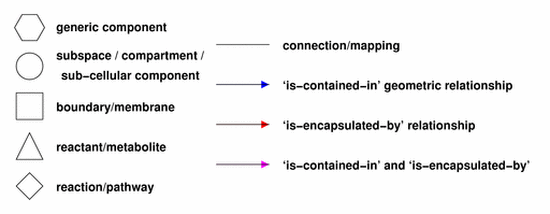Graphical Notation for CellML Networks
It is useful to have a concise graphical representation for CellML networks, which can provide an overview of an entire model at a glance. The examples presented on this website use a notation based on the simple rendering conventions developed by the CellML team during discussions of basic models. These rendering conventions represent a classification of components into some simple types drawn from the fields of electrophysiological and reaction/pathway modelling, as well as a classification of the relationships that can exist between any two components. It is no coincidence that the rendering conventions developed were easily renderable on a whiteboard!
Figure 1 provides a key to these rendering conventions. The second and third classes of component are most commonly found in electrophysiological models, whereas the fourth and fifth classes of component are used in pathway/reaction modelling.


